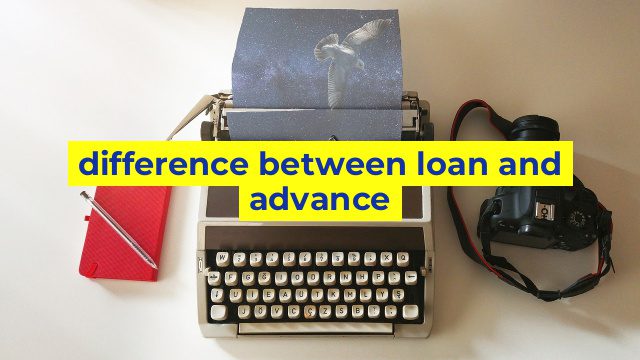The Crucial Difference Between Loan and Advance
Getting financial aid can be beneficial in countless ways, especially for those who are going through tough financial times. However, choosing the right financial aid that suits your requirements can be confusing. One such daunting decision is opting for a loan or advance. Although both financial products aim to provide instant cash, there are distinct differences between them.
What is a Loan?
A loan is a sum of money that is borrowed from a financial institution, such as a bank or a credit union, for a specific period. The borrower agrees to pay back the loan amount along with interest within the set timeframe, usually in monthly installments. Loans can be categorized into two types – secured and unsecured loans. A secured loan is backed by collateral, while an unsecured loan doesn’t require any collateral. The amount of loan and interest rate depend on several factors, such as credit score, credit history, and the duration of the loan.
What is an Advance?
An advance, on the other hand, is a type of loan but with a difference. An advance is a cash advance against your regular income, such as your salary or business revenue. It is usually a short-term loan, and the borrower pays it back in full on their payday. Advances are often used by people who are facing immediate financial issues, such as unexpected medical expenses or vehicle repairs. Advances can be taken from banks or financial institutions, but many companies book emergency or salary advances for their employees.
Key Differences Between Loans and Advances
The primary difference between a loan and an advance is their duration. Loans are usually long-term commitments that can last from months to years, while advances are short-term loans that are due in a few weeks or until the next payday. The amount of the loan or advance also differs, as advances are typically smaller than loans.
Another fundamental difference between loans and advances is their interest rates. Loans usually have a lower interest rate than advances, as they are long-term financial products where the borrower has more time to pay off the debt. Advances, on the other hand, have higher interest rates since they are short-term loans.
Conclusion
Both loans and advances can be useful for meeting financial needs. However, each has its unique characteristics that make them different from one another. Loans are suitable for long-term financial goals, such as home buying or education, while advances are ideal for short-term financial issues. When selecting between a loan and an advance, consider the repayment terms, interest rates, and loan duration to ensure you choose the most appropriate financial aid for your needs.
Table difference between loan and advance
| Loan | Advance |
|---|---|
| A loan is a sum of money borrowed by an individual or a company from a financial institution, with the agreement to pay it back with interest over a period of time. | An advance is a sum of money given to an individual by their employer, usually as an advance on their salary. |
| Loans are typically for much larger amounts of money and are used for long-term investments, such as purchasing a house or a car. | Advances are usually for smaller amounts of money and are used for short-term expenses, such as paying for bills or unexpected emergency expenses. |
| To obtain a loan, a borrower typically needs to provide collateral, such as a house or car, to secure the loan. | Advances do not require collateral and are based more on the individual’s ability to repay the advance. |
| Loan repayments are typically in equal installments over a period of time. | Advances are usually deducted from the employee’s future paychecks over a short period of time. |
| Interest rates on loans are typically higher than those for advances, because the lender is taking on more risk. | Interest rates on advances are usually lower than those for loans, because the lender is taking less risk. |

